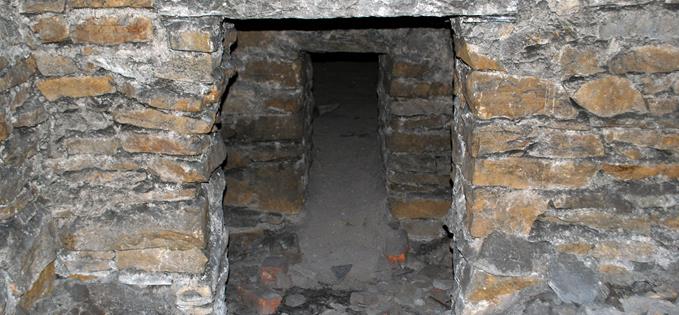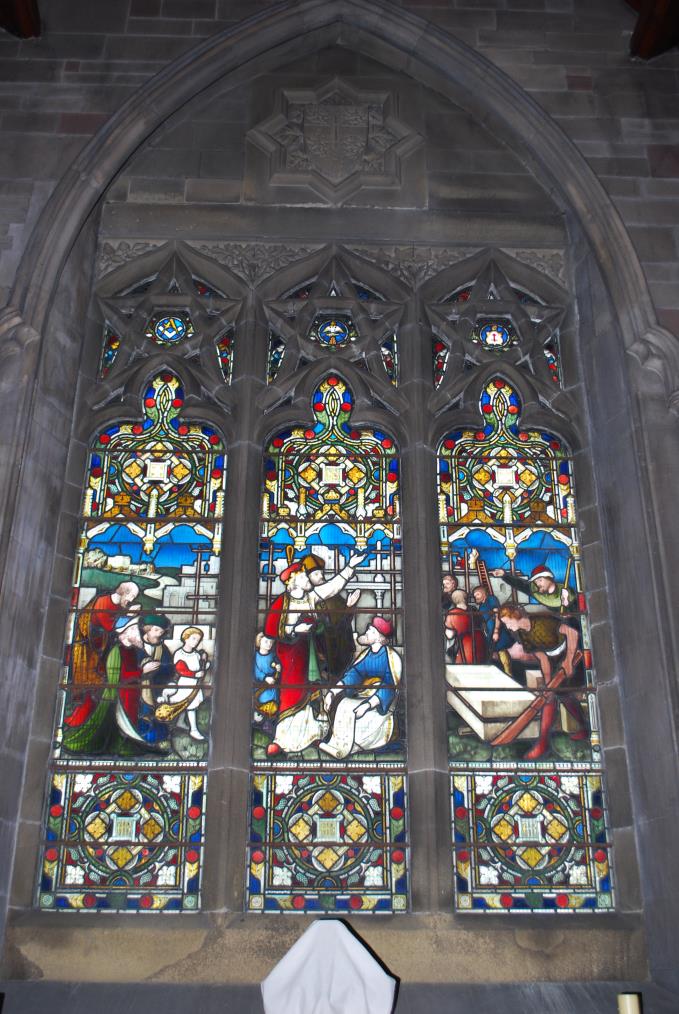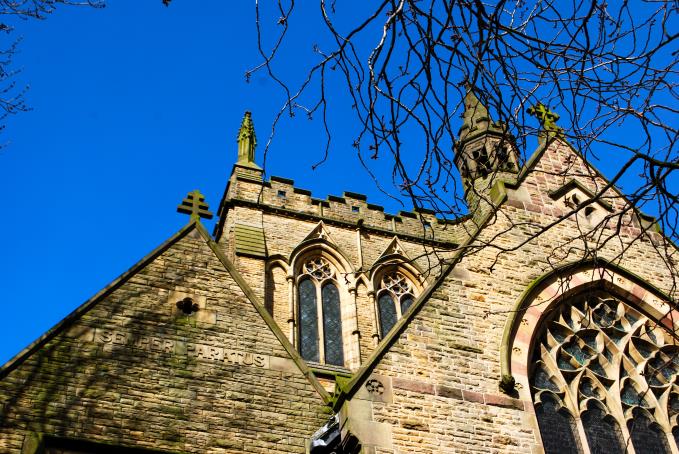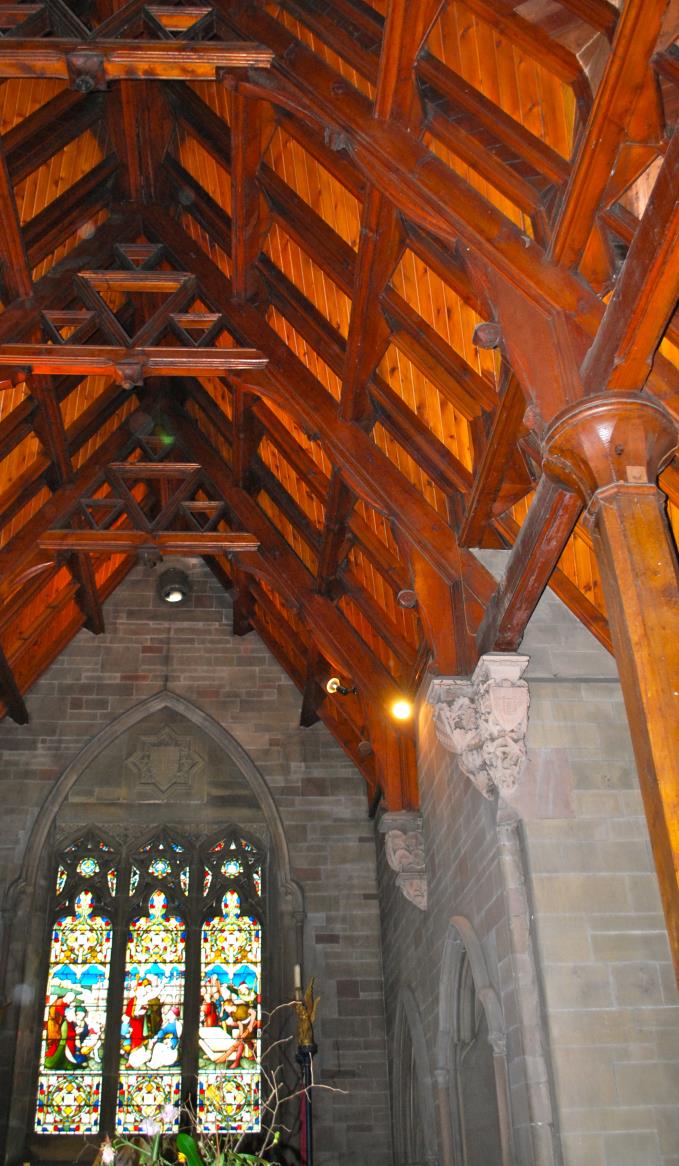GRADE I listed, Church of St Edmund, ‘Rochdale’s Temple to Freemasonry’ (Pevsner), is a puzzle. Tucked away at a crossroad of semis, it is situated on a diamond shaped plot, once the highest point of the township of Rochdale. Ambling past, it looks like any other 19th century parish church. Closer inspection reveals a fascinating abundance of Freemason symbolism in the Gothic revival style.
Stooping through labyrinthine corridors and antechambers of rough and polished stone, one reaches a room in which an arch is set, as if an earlier church stood here.
Apparently, Dan Brown has lamented on his not discovering St Edmund’s prior to his writing in something approaching English all those codebooks. Whilst Rosslyn Chapel in Scotland has become the most famous example of a church associated with Freemasonry, it was not built with that in mind, the secret symbols added centuries after construction. St Edmund’s however was designed and built by Freemasons and is covered in, out and under with secrets.
Albert Royds, Rochdale banker and Freemason, commissioned Manchester architect J Medland Taylor to design the church, although Royds himself and Rev EW Gilbert (artist, Freemason and first incumbent) heavily influenced the final result. Built between 1870-1873 when the average cost of building a church was £4,000, St Edmund’s cost at least £28,000 not including fixtures and fittings.
The story of Solomon’s Temple is the primary Masonic allegory and it helps to have some background on this to appreciate the significance of what Royds set out to achieve with St Edmund’s. For readers who didn’t go to Sunday school, the story goes that King Solomon built the Temple on Mount Zion to house the Ark of the Covenant, which contained the Ten Commandments. Sacrifice was the predominant mode of divine service at the Temple until Nebuchadnezzar destroyed it in 586 BC. Seventy years later Ezra and Nehemiah built a second temple on the same site and sacrifices to God were resumed.
Back to Rochdale and when approached from Clement Royds Street, St Edmund’s seems to loom out of the ground. The first thing one used to see was the bronze pentagram weathervane, which is now propped up next to the organ due to it having been struck by lightning. The four arms of the church surround a lantern tower and the whole thing sits upon an ashlar plinth.

Unfortunately the lantern tower was sealed in 1887 due to down draughts. Ascending the narrow stone staircase in one of the turrets you can see the huge windows that would have flooded the knave with light. The lantern tower is the seventh cube of the interior: two in the knave and the four arms of the church being the others. The roof provides great views over Rochdale, the 1960’s high-rise flats known locally as the Seven Sisters and the Pennines beyond.

Akin to King Solomon, Royds shipped cedar wood from Lebanon for the impressively carved hammer beams, spandrels and tie beams, all set in geometric patterns. Rev Gilbert’s carved stone reredos has the words ‘I AM THE’ emerging from the vine and above the enormous granite columns that appear to support the lantern tower, are intricate carvings of lilies, pomegranates and forget-me-nots. These were the symbols of Freemasonry before the square and compasses. Positioned on two large stone cubes, the brass lectern sits upon three columns: Doric, Ionic and Corinthian with the more familiar symbolic tools of the Freemasons at their bases.

The Old Testament illustrations on the stained glass are by Lavers, Barraud & Westlake with some design by Henry Holiday. The south windows depict creation, the north damnation. The east window in Royds Chapel contains much Freemason symbolism including Knight’s Templar and Salem’s crosses. The figures are pictured building Solomon’s Temple with Albert Royds playing the master builder. Ezra and Nehemiah each have a window in the Royds Chapel as does a Masonic Tyler with Solomon’s sword who guards the entrance.
Perhaps most astonishing is the crypt, which whilst not used as a burial chamber, appears to have been designed for another purpose. Its use for rituals and ceremonies has been denied although it has been confirmed that Royds intentionally made it look as if an earlier church stood on St Edmund’s foundations, which is really going the extra mile with the Solomon’s Temple allegory. Stooping through labyrinthine corridors and antechambers of rough and polished stone, one reaches a room in which an arch is set, as if an earlier church stood here. Below the arch set in the wall is a scratched stone with a chiselled space as if it once held an object. Whether this object was nicked or just made to look so as part of Royds’ hoax remains a mystery.

The Victorian Society named St Edmund's as one of the UK's most endangered buildings in 2009 and since then The Churches Conservation Trust has spent £120,000 on roof and masonry repairs. Completed prior to the church re-opening to the public last year, these were the first of a two phase plan. The second phase includes repairs to the Hill & Son 1872 organ and work on the lighting. The church also has the potential as a small scale concert and lecture venue, which is a potential way of raising the funds for further restoration.
In the meantime, the church is maintained by the Friends of St Edmund's and is open to the public on the first and third third Saturdays of the month from 11am-4pm, staying open later in the summer months.
For more information and/or to book a tour visit: Facebook: Friends of St Edmund's. Twitter: @stedmundroch You can follow Laura Marsden on Twitter here.














